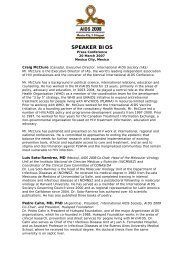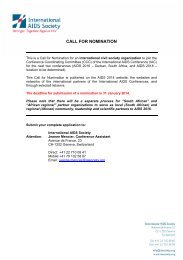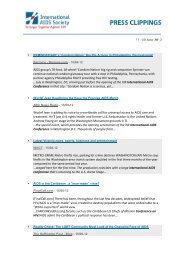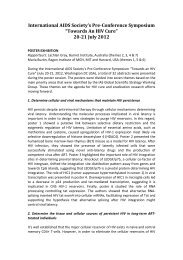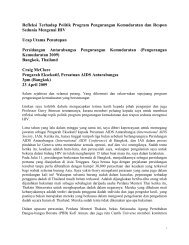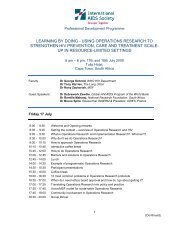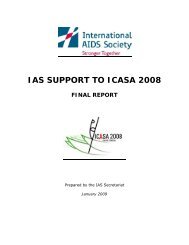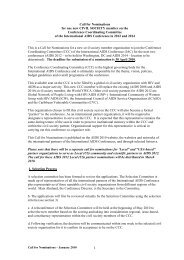Advocacy in Action - International AIDS Society
Advocacy in Action - International AIDS Society
Advocacy in Action - International AIDS Society
Create successful ePaper yourself
Turn your PDF publications into a flip-book with our unique Google optimized e-Paper software.
ACTIVITY<br />
2.1 Objective: By the end of this session<br />
participants will be able to select an<br />
appropriate advocacy issue or problem<br />
Section 2.1 Step 1: Select the issue or problem you want to address<br />
Introduction<br />
• It is important to th<strong>in</strong>k carefully about an issue before plann<strong>in</strong>g advocacy work. Steps 1 and<br />
2 help this process.<br />
• It is necessary to consider the different issues that could be worked with, and to select ones<br />
that are realistic and which will benefit from advocacy.<br />
• It is important to def<strong>in</strong>e the selected problem or issue clearly.<br />
• If possible, make sure that the people affected by the issue are <strong>in</strong>volved <strong>in</strong> def<strong>in</strong><strong>in</strong>g the<br />
issue and plann<strong>in</strong>g the process from the beg<strong>in</strong>n<strong>in</strong>g. They will have expert knowledge of the<br />
situation, and will add strength and legitimacy to the advocacy work (see Handout 2,<br />
‘Effective Representation (legitimacy)’ at the end of this section). For example, this<br />
<strong>in</strong>volvement can be facilitated through drama (see <strong>Advocacy</strong> <strong>in</strong> <strong>Action</strong> Card 6,<br />
‘Communicat<strong>in</strong>g through drama’).<br />
Note:<br />
If participants choose an issue that directly affects a group of people not represented at the<br />
workshop, it will of course be necessary to repeat the plann<strong>in</strong>g process after the workshop,<br />
with the <strong>in</strong>volvement of the people directly affected. Because of this, the emphasis of the<br />
workshop should be on participants learn<strong>in</strong>g the advocacy plann<strong>in</strong>g process, rather than<br />
develop<strong>in</strong>g a real plan of action.<br />
Instructions<br />
Tim<strong>in</strong>g: 1 hour 30 m<strong>in</strong>utes<br />
1 Expla<strong>in</strong> the objective of this step, <strong>in</strong>troduce the topic and the activity.<br />
2 Work<strong>in</strong>g with the whole group, ask the participants the follow<strong>in</strong>g question:<br />
? How do we decide which issues to address for advocacy work?<br />
3 Expla<strong>in</strong> that with<strong>in</strong> their groups they will need a timekeeper, writer and rapporteur<br />
(presenter) for the activities with<strong>in</strong> each step of the advocacy framework. Ask the groups to<br />
document all their work to present to the whole group at a later stage.<br />
4 Us<strong>in</strong>g the follow<strong>in</strong>g guidel<strong>in</strong>e questions, ask each small group to bra<strong>in</strong>storm a number of<br />
HIV/<strong>AIDS</strong>-related issues that could be addressed through advocacy at their assigned level<br />
(assigned dur<strong>in</strong>g the previous activity):<br />
? What are you try<strong>in</strong>g to achieve? What is your f<strong>in</strong>al aim or goal?<br />
? What barriers or problems do you face <strong>in</strong> your work? Which barriers or problems could<br />
be overcome by advocacy?<br />
5 When the groups have made a list of possible issues, ask them to select the best one for<br />
advocacy, us<strong>in</strong>g matrix rank<strong>in</strong>g. They can rank issues us<strong>in</strong>g the follow<strong>in</strong>g k<strong>in</strong>d of criteria:<br />
? To what extent can this issue be solved by advocacy?<br />
? To what extent would a solution to this issue help people directly affected?<br />
? Can people directly affected by the issue be <strong>in</strong>volved <strong>in</strong> the advocacy work?<br />
6 Circulate around the groups to ensure that they have all agreed on an appropriate issue to<br />
address. Ask them to write the issue on flip-chart paper and display it on the wall. It is not<br />
necessary for the groups to present their work at this stage.<br />
36




